Macro Photography as an Alternative to the Stereoscopic Microscope in the Standard Test Method for Microscopical Characterisation of the Air-Void System in Hardened Concrete: Equipment and Methodology
Abstract
:1. Introduction
- The various size voids in the real system are replaced by single-size voids in the simplified system. The pore size in the simplified system must guarantee the same surface area and total pore volume in both systems.
- The random distribution of air voids in the real system is replaced by a geometrically regular pattern of single-size voids arranged in a uniform, three-dimensional grid in the simplified system.
2. Proposed Methodology Based on Macro-Photographic Images
2.1. Equipment
- Photographic camera with life-view shooting mode. While the life-view mode is not strictly necessary from a technical point of view, as later will be observed, it makes the procedure significantly easier to perform.
- Macro photography lenses and extension tubes these elements may vary from one piece of equipment to another. In fact, if a sufficiently high-quality macro photography lens is available, the extension tubes may be unnecessary. The extension tubes are merely an option to define a less expensive way of obtaining macro-photographic images.
- Remote-shutter camera. Although this element is also not strictly necessary from a technical point of view, it helps to guarantee a correct capture of the whole surface analysed, especially when the macro-photographic images are obtained by using extension tubes, which reduces the lighting on the specimen very much and makes it more prone to obtain blurry images.
- Horizontal tripod. Any solid enough tripod is valid, on the condition that it allows for the camera to be placed in a horizontal position, as shown in Figure 1.
- Precision cross table. It must provide a displacement range in both directions sufficient to cover the whole area of analysis.
- Spirit level or similar levelling device.
- Lamp.
- Computer-aided design (CAD) software.
2.2. Methodology Description
- Place the prepared surface on the cross table. The polished surface must be in a horizontal position, since a minor error in levelling would result in unfocused images.
- Place the photographic camera, with the remote shutter connected and equipped with the macro lens and the extension tubes if necessary, on the tripod so that the camera is horizontal and at a right distance from the prepared surface to obtain a focused image. This step must be carefully performed to ensure that both the camera sensor and the prepared surface are parallel, if they are not, partially blurry images will be obtained.
- Adjust the lamp position so that the light beam illuminates evenly the area that the camera will record at each capture. The angle that is formed by the light beam and the prepared surface must be low to increase the contrast between the air voids and the polished plane, and therefore, to facilitate the identification of voids in a later step. This position must be fixed for each sample. It must be noted that, since the only element that moves during the process is the surface of the cross-table where the sample is placed, all of the images are obtained with the same illumination conditions, which is necessary for correctly identifying voids, paste, and aggregates later.
- Adjust the camera settings so that the captured image is focused and the voids can be easily identified.
- Place the sample, by using the screws of the cross table, so that the camera captures one of the corners of the rectangle that defines the surface to be analysed and take the first picture by using the remote shutter.
- Using the screws of the cross table (either north-south or east-west directions) the whole rectangle must be photographed by capturing pictures that must have overlapping areas for later assembling. An example of this procedure is shown in the bottom-right corner of Figure 1.
- Assemble the images by using computer-aided design (CAD) software. An image of the whole marked rectangle surface must be obtained by overlapping the thin common areas between each pair of consecutive pictures. Figure 3 shows an example of how the picture borders overlap and covers the whole rectangular area of analysis.
- Analyse the resulting image to determine what is found at each intersection of the grid, air void, paste or aggregate, and the number of air voids that are crossed by the horizontal lines of the grid.
2.3. Computation of the Spacing Factor
- total number of air voids.
- total number of stops.
- number of stops in air voids.
- number of stops in paste.
- the E-W translation distance between stops.
3. Results and Discussion
3.1. Specimens
3.2. Results and Discussion
3.2.1. Results of 27 Dosages by One Operator
3.2.2. Results of Five Dosages by Two Operators
3.2.3. Comparison with the Original Methodology
4. Conclusions
- A more comfortable procedure for the operator. The tedious task of identifying voids, aggregates and cement paste in the surface of analysis can be performed by using a computer screen instead of a stereoscopic microscope.
- A significant reduction in equipment cost.
- The convenience of saving the photographic compositions of the marked surface should it be necessary to repeat the observation. This avoids the need of saving and maintaining the concrete slabs in the proper conditions.
Author Contributions
Funding
Conflicts of Interest
Appendix A
| Dosage Denomination | Average Value of Spacing factor | Standard Deviation (1s) | Range of Two Test Results (d2s) | Coefficient of Variation (1s%) | Range of Two Test Results (d2s%) |
|---|---|---|---|---|---|
| C1 | 0.385 | 0.02 | 0.07 | 6.2 | 17.7 |
| C2 | 0.300 | 0.03 | 0.10 | 11.3 | 32.0 |
| C3 | 0.384 | 0.00 | 0.00 | 0.3 | 0.8 |
| C4 | 0.401 | 0.07 | 0.20 | 17.5 | 49.6 |
| C5 | 0.349 | 0.04 | 0.10 | 10.1 | 28.4 |
| C6 | 0.472 | 0.03 | 0.10 | 7.4 | 20.9 |
| C7 | 0.346 | 0.04 | 0.13 | 12.9 | 36.6 |
| C8 | 0.352 | 0.02 | 0.05 | 4.9 | 13.8 |
| C9 | 0.421 | 0.03 | 0.07 | 6.1 | 17.3 |
| C10 | 0.314 | 0.03 | 0.10 | 11.0 | 31.2 |
| C11 | 0.313 | 0.04 | 0.10 | 11.7 | 33.1 |
| C12 | 0.245 | 0.00 | 0.01 | 1.5 | 4.2 |
| C13 | 0.290 | 0.02 | 0.07 | 8.4 | 23.6 |
| C14 | 0.314 | 0.01 | 0.02 | 2.7 | 7.6 |
| C15 | 0.324 | 0.03 | 0.09 | 9.6 | 27.2 |
| C16 | 0.321 | 0.03 | 0.07 | 8.2 | 23.1 |
| C17 | 0.288 | 0.00 | 0.01 | 1.2 | 3.5 |
| C18 | 0.280 | 0.01 | 0.03 | 3.3 | 9.3 |
| C19 | 0.299 | 0.02 | 0.06 | 7.1 | 20.1 |
| C20 | 0.282 | 0.04 | 0.10 | 13.0 | 36.9 |
| C21 | 0.319 | 0.02 | 0.05 | 5.6 | 15.7 |
| C22 | 0.287 | 0.02 | 0.04 | 5.4 | 15.3 |
| C23 | 0.265 | 0.01 | 0.04 | 5.1 | 14.4 |
| C24 | 0.292 | 0.05 | 0.13 | 15.5 | 43.8 |
| C25 | 0.277 | 0.01 | 0.04 | 5.4 | 15.2 |
| C26 | 0.309 | 0.01 | 0.03 | 3.0 | 8.4 |
| C27 | 0.301 | 0.02 | 0.07 | 8.2 | 23.3 |
| Average | 0.02 | 0.07 | 7.5 | 21.2 |
| Dosage Denomination | Average Value of Voids Intersected/cm | Standard Deviation (1s) | Range of Two Test Results (d2s) | Coefficient of Variation (1s%) | Range of Two Test Results (d2s%) |
|---|---|---|---|---|---|
| C1 | 1.71 | 0.107 | 0.30 | 6.2 | 17.6 |
| C2 | 2.41 | 0.411 | 1.16 | 17.0 | 48.1 |
| C3 | 2.37 | 0.115 | 0.33 | 4.8 | 13.7 |
| C4 | 1.61 | 0.082 | 0.23 | 5.1 | 14.5 |
| C5 | 2.28 | 0.294 | 0.83 | 12.9 | 36.4 |
| C6 | 1.70 | 0.004 | 0.01 | 0.2 | 0.7 |
| C7 | 2.38 | 0.111 | 0.31 | 4.7 | 13.2 |
| C8 | 2.39 | 0.055 | 0.16 | 2.3 | 6.6 |
| C9 | 1.92 | 0.386 | 1.09 | 20.1 | 56.9 |
| C10 | 2.71 | 0.023 | 0.06 | 0.8 | 2.4 |
| C11 | 2.34 | 0.049 | 0.14 | 2.1 | 6.0 |
| C12 | 2.23 | 0.014 | 0.04 | 0.6 | 1.8 |
| C13 | 2.75 | 0.072 | 0.20 | 2.6 | 7.4 |
| C14 | 2.69 | 0.119 | 0.34 | 4.4 | 12.5 |
| C15 | 2.52 | 0.096 | 0.27 | 3.8 | 10.8 |
| C16 | 2.64 | 0.037 | 0.10 | 1.4 | 4.0 |
| C17 | 2.46 | 0.062 | 0.17 | 2.5 | 7.1 |
| C18 | 2.94 | 0.388 | 1.10 | 13.2 | 37.3 |
| C19 | 2.96 | 0.368 | 1.04 | 12.4 | 35.1 |
| C20 | 3.05 | 0.244 | 0.69 | 8.0 | 22.7 |
| C21 | 2.77 | 0.302 | 0.85 | 10.9 | 30.8 |
| C22 | 2.66 | 0.125 | 0.35 | 4.7 | 13.3 |
| C23 | 2.68 | 0.039 | 0.11 | 1.5 | 4.1 |
| C24 | 2.92 | 0.129 | 0.37 | 4.4 | 12.5 |
| C25 | 3.22 | 0.066 | 0.19 | 2.0 | 5.8 |
| C26 | 2.30 | 0.435 | 1.23 | 18.9 | 53.5 |
| C27 | 2.59 | 0.236 | 0.67 | 9.1 | 25.8 |
| Average | 0.162 | 0.46 | 6.6 | 18.5 |
| Dosage Denomination | Average Value of Air Content | Standard Deviation (1s) | Range of Two Test Results (d2s) | Coefficient of Variation (1s%) | Range of Two Test Results (d2s%) |
|---|---|---|---|---|---|
| C1 | 4.94 | 0.246 | 0.70 | 5.0 | 14.1 |
| C2 | 5.63 | 0.575 | 1.63 | 10.2 | 28.9 |
| C3 | 6.85 | 0.739 | 2.09 | 10.8 | 30.5 |
| C4 | 3.83 | 0.575 | 1.63 | 15.0 | 42.4 |
| C5 | 5.40 | 0.329 | 0.93 | 6.1 | 17.2 |
| C6 | 5.23 | 0.493 | 1.39 | 9.4 | 26.7 |
| C7 | 6.62 | 1.314 | 3.72 | 19.8 | 56.1 |
| C8 | 5.66 | 0.205 | 0.58 | 3.6 | 10.3 |
| C9 | 5.37 | 1.519 | 4.30 | 28.3 | 80.0 |
| C10 | 6.07 | 1.191 | 3.37 | 19.6 | 55.5 |
| C11 | 4.67 | 1.437 | 4.07 | 30.7 | 87.0 |
| C12 | 2.76 | 0.123 | 0.35 | 4.5 | 12.6 |
| C13 | 5.14 | 0.534 | 1.51 | 10.4 | 29.4 |
| C14 | 6.45 | 0.082 | 0.23 | 1.3 | 3.6 |
| C15 | 5.81 | 0.411 | 1.16 | 7.1 | 20.0 |
| C16 | 6.36 | 0.452 | 1.28 | 7.1 | 20.1 |
| C17 | 4.91 | 0.041 | 0.12 | 0.8 | 2.4 |
| C18 | 6.39 | 1.560 | 4.41 | 24.4 | 69.1 |
| C19 | 7.06 | 0.945 | 2.67 | 13.4 | 37.9 |
| C20 | 6.88 | 0.616 | 1.74 | 8.9 | 25.3 |
| C21 | 7.08 | 1.643 | 4.65 | 23.2 | 65.6 |
| C22 | 5.78 | 0.945 | 2.67 | 16.3 | 46.2 |
| C23 | 5.40 | 0.575 | 1.63 | 10.6 | 30.1 |
| C24 | 6.79 | 2.217 | 6.27 | 32.6 | 92.3 |
| C25 | 7.38 | 0.411 | 1.16 | 5.6 | 15.8 |
| C26 | 4.70 | 1.068 | 3.02 | 22.7 | 64.2 |
| C27 | 5.60 | 1.437 | 4.06 | 25.6 | 72.5 |
| Average | 0.803 | 2.27 | 13.8 | 39.1 |
| Dosage Denomination | Average Value of Paste Content | Standard Deviation (1s) | Range of Two Test Results (d2s) | Coefficient of Variation (1s%) | Range of Two Test Results (d2s%) |
|---|---|---|---|---|---|
| C1 | 33.71 | 1.930 | 5.46 | 5.7 | 16.2 |
| C2 | 34.76 | 0.123 | 0.35 | 0.4 | 1.0 |
| C3 | 46.37 | 0.780 | 2.21 | 1.7 | 4.8 |
| C4 | 43.15 | 4.024 | 11.38 | 9.3 | 26.4 |
| C5 | 45.50 | 0.534 | 1.51 | 1.2 | 3.3 |
| C6 | 48.40 | 2.094 | 5.92 | 4.3 | 12.2 |
| C7 | 38.88 | 2.176 | 6.16 | 5.6 | 15.8 |
| C8 | 48.64 | 0.616 | 1.74 | 1.3 | 3.6 |
| C9 | 47.85 | 1.807 | 5.11 | 3.8 | 10.7 |
| C10 | 46.49 | 1.109 | 3.14 | 2.4 | 6.7 |
| C11 | 46.66 | 3.655 | 10.34 | 7.8 | 22.2 |
| C12 | 45.62 | 1.766 | 4.99 | 3.9 | 10.9 |
| C13 | 49.13 | 0.000 | 0.00 | 0.0 | 0.0 |
| C14 | 42.31 | 0.862 | 2.44 | 2.0 | 5.8 |
| C15 | 44.37 | 1.889 | 5.34 | 4.3 | 12.0 |
| C16 | 43.15 | 2.874 | 8.13 | 6.7 | 18.8 |
| C17 | 39.66 | 0.657 | 1.86 | 1.7 | 4.7 |
| C18 | 40.65 | 2.874 | 8.13 | 7.1 | 20.0 |
| C19 | 41.84 | 1.848 | 5.23 | 4.4 | 12.5 |
| C20 | 40.22 | 0.041 | 0.12 | 0.1 | 0.3 |
| C21 | 41.81 | 3.367 | 9.52 | 8.1 | 22.8 |
| C22 | 38.94 | 0.945 | 2.67 | 2.4 | 6.9 |
| C23 | 35.63 | 0.452 | 1.28 | 1.3 | 3.6 |
| C24 | 41.20 | 1.519 | 4.30 | 3.7 | 10.4 |
| C25 | 40.45 | 0.287 | 0.81 | 0.7 | 2.0 |
| C26 | 42.07 | 3.326 | 9.41 | 7.9 | 22.4 |
| C27 | 42.22 | 2.874 | 8.13 | 6.8 | 19.3 |
| Average | 1.646 | 4.65 | 3.9 | 10.9 |
References
- Romero Mendoza, H.L. Deterioro del hormigón sometido a ensayos acelerados de hielo-deshielo en presencia de cloruros. Ph.D. Thesis, Technical University Madrid, Madrid, Spain, September 2011. [Google Scholar]
- Scott, M. Determining the Air Void Parameters of Concrete Using Digital Image Analysis of Polarized Light Micrographs. Ph.D. Thesis, Virginia Polytechnic Institute and State University, Blacksburg, VA, USA, April 1997. [Google Scholar]
- Sutter, L.L.; Van Dam, T.; Thomas, M. Evaluation of Methods for Characterizing Air Void Systems in Wisconsin Paving Concrete; No. WHRP 07-0; Wisconsin Highway Research Program, 2007; Available online: https://minds.wisconsin.edu/handle/1793/53316 (accessed on 20 August 2018).
- Powers, T.C. A Working Hypothesis for Further Studies of Frost Resistance of Concrete; American Concrete Institute: Farmington Hills, MI, USA, 1945; Volume 41, pp. 245–272. [Google Scholar]
- Vosahlik, J. Air Void Clustering in Concrete. Ph.D. Thesis, Kansas State University, Manhattan, KS, USA, August 2014. [Google Scholar]
- Pleau, R.; Pigeon, M.; Laurencot, J.L. Some findings on the usefulness of image analysis for determining the characteristics of the air-void system on hardened concrete. Cem. Concr. Compos. 2001, 23, 237–246. [Google Scholar] [CrossRef]
- Walker, H.N. FHWA-RD-97-146, Petrographic Methods of Examining Hardened Concrete: A Petrographic Manual (Revised 2004); Virginia Transportation Research Council: McLean, VA, USA, July 2006. Available online: https://www.fhwa.dot.gov/publications/research/infrastructure/pavements/pccp/04150/04150.pdf (accessed on 22 August 2018).
- ASTM International. ASTM C457/C457M-12. Standard Test Method for Microscopical Determination of Parameters of the Air-Void System in Hardened Concrete; ASTM International: West Conshohocken, PA, USA, 2012; Available online: http://www.c-s-h.ir/wp-content/uploads/2015/01/C-457.pdf (accessed on 22 August 2018).
- Powers, T.C. Void Space as a Basis for Producing Air-Entrained Concrete; American Concrete Institute: Farmington Hills, MI, USA, 1954; Volume 50, pp. 741–759. [Google Scholar]
- Powers, T.C.; Willis, T.F. The air requirement of frost resistant concrete. In Proceedings of the Twenty-Ninth Annual Meeting of the Highway Research, Washington, DC, USA, 13–16 December 1949; Highway Research Board: Washington, DC, USA, 1950; pp. 184–211. [Google Scholar]
- Lamond, J.F.; Pielert, J.H. Significance of Tests and Properties of Concrete and Concrete-Making Materials; ASTM International: West Conshohocken, PA, USA, 2006. [Google Scholar]
- Pigeon, M.; Gagne, R.; Foy, C. Critical air-void spacing factors for low water-cement ratio concretes with and without condensed silica fume. Cem. Concr. Res. 1987, 17, 896–906. [Google Scholar] [CrossRef]
- Jana, D. A round robin test on measurements of air void parameters in hardened concrete by various automated image analyses and ASTM C 457 methods. In Proceedings of the 29th Conference on Cement Microscopy, Quebec, QC, Canada, 20–24 May 2007; Available online: http://nebula.wsimg.com/f034e368f9883ea25cb4d2c56f414822?AccessKeyId=D94D99729EAEC69E9267&disposition=0&alloworigin=1 (accessed on 22 August 2018).
- Jakobsen, U.H.; Pade, C.; Thaulow, N.; Brown, D.; Sahu, S.; Magnusson, O.; De Schutter, G. Automated air void analysis of hardened concrete—A Round Robin study. Cem. Concr. Res. 2006, 36, 1444–1452. [Google Scholar] [CrossRef]
- Baumgart, C.; Blair, R.; Linder, K. Image Analysis of Hardened Concrete Performance Enhancement of the Automated Concrete Evaluation System (ACES) (No. OR 07-004). 2006. Available online: https://trid.trb.org/view/859388 (accessed on 20 August 2018).
- Zalocha, D.; Kasperkiewicz, J. Estimation of the structure of air entrained concrete using a flatbed scanner. Cem. Concr. Res. 2005, 35, 2041–2046. [Google Scholar] [CrossRef]
- Peterson, K.W.; Swartz, R.A.; Sutter, L.L.; Van Dam, T.J. Air void analysis of hardened concrete with a high-resolution flatbed scanner. In Proceedings of the 24th International Conference on Cement Microscopy, San Diego, CA, USA, 7–11 April 2002. [Google Scholar]
- Glinicki, M.A.; Zielinski, M. Air void system in concrete containing circulating fluidized bed combustion fly ash. Mater. Struct. 2008, 41, 681–687. [Google Scholar] [CrossRef]
- Fonseca, P.C.; Scherer, G.W. An image analysis procedure to quantify the air void system of mortar and concrete. Mater. Struct. 2015, 48, 3087–3098. [Google Scholar] [CrossRef]
- ASTM International. ASTM C670-13, Standard Practice for Preparing Precision and Bias Statements for Test Methods for Construction Materials; ASTM International: West Conshohocken, PA, USA, 2013. [Google Scholar]
- Hermann, S. The precision of the microscopical determination of the air-void system in hardened concrete. Cem. Concr. Aggreg. 1979, 1, 49–55. [Google Scholar]
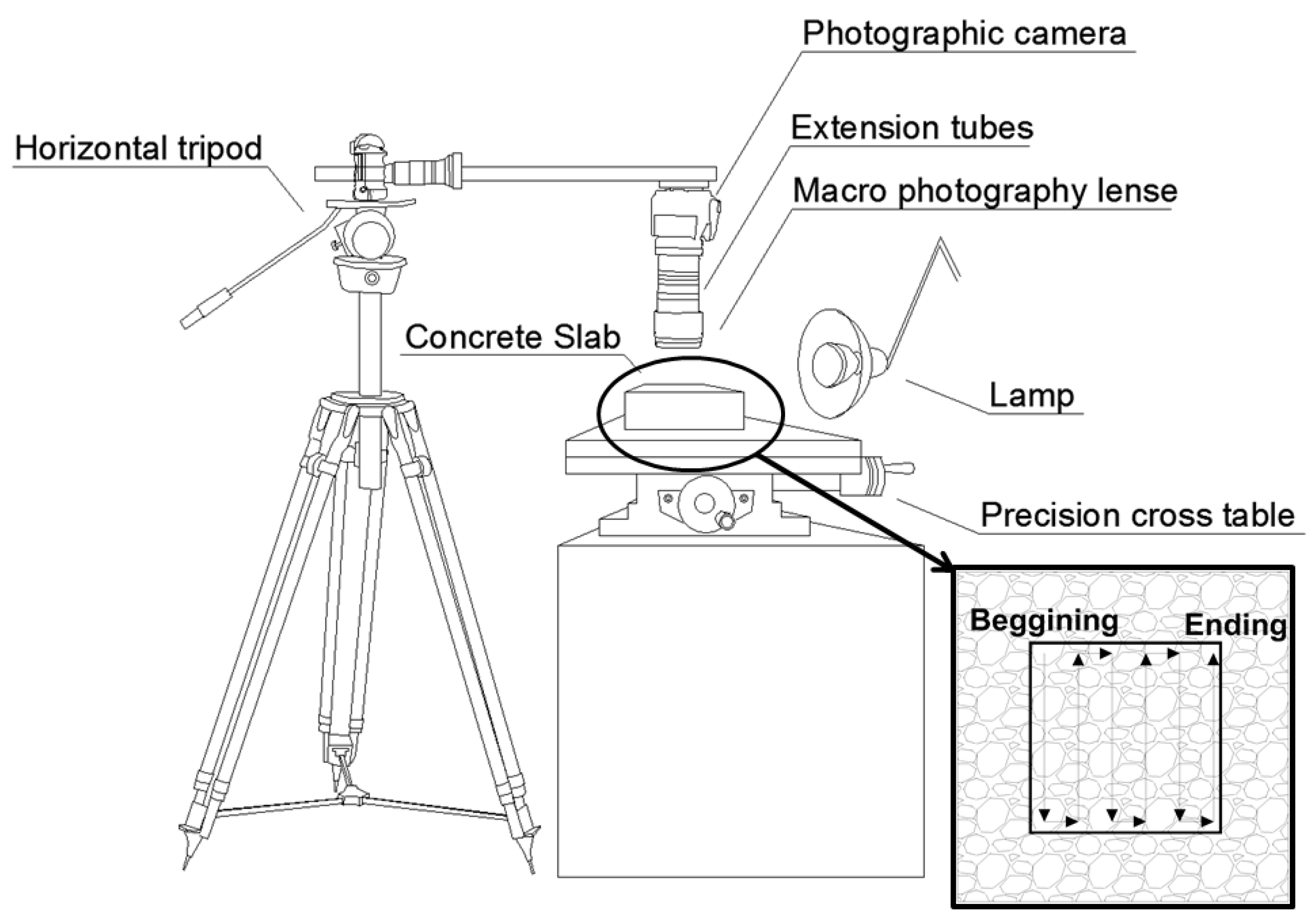

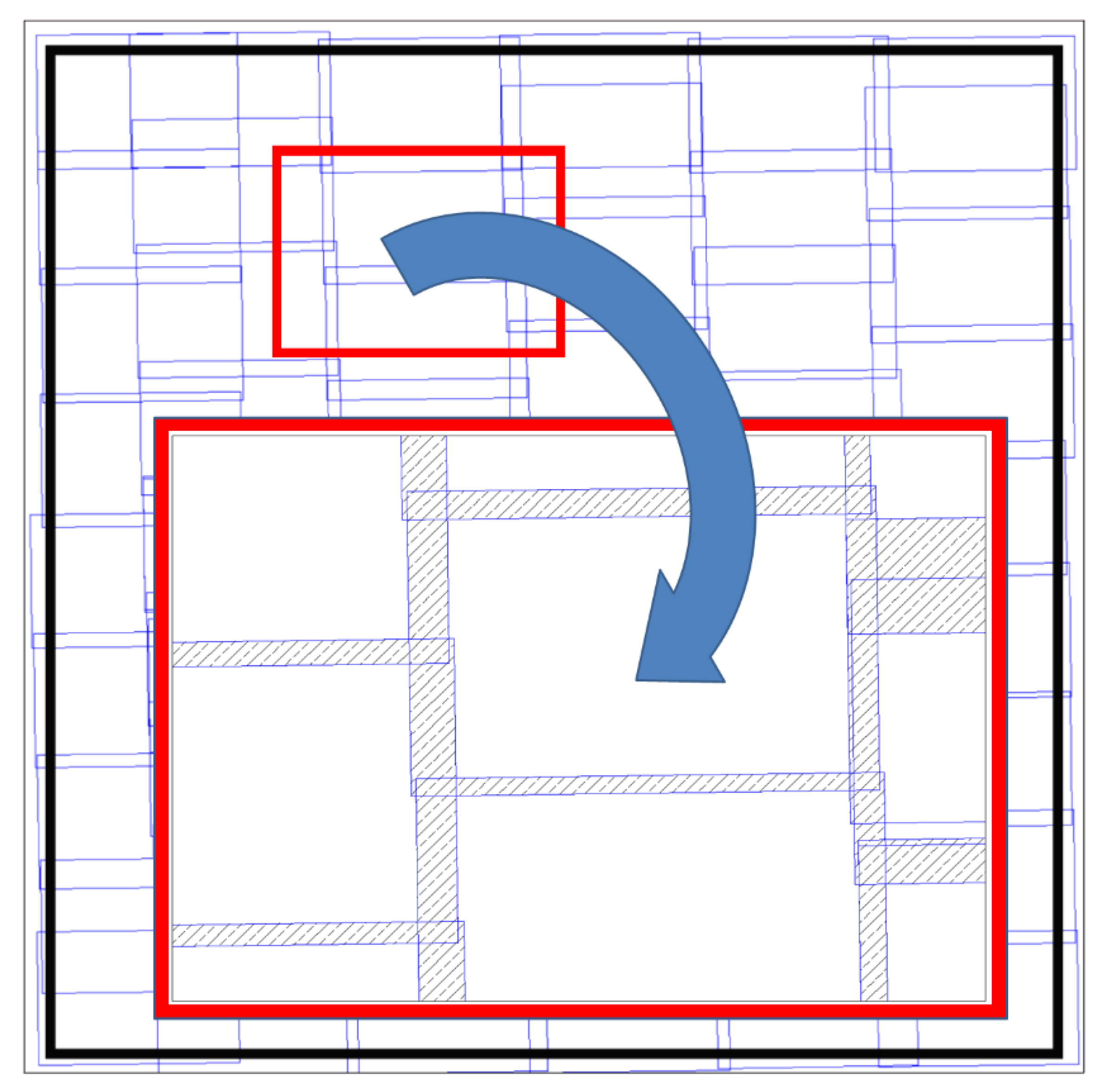
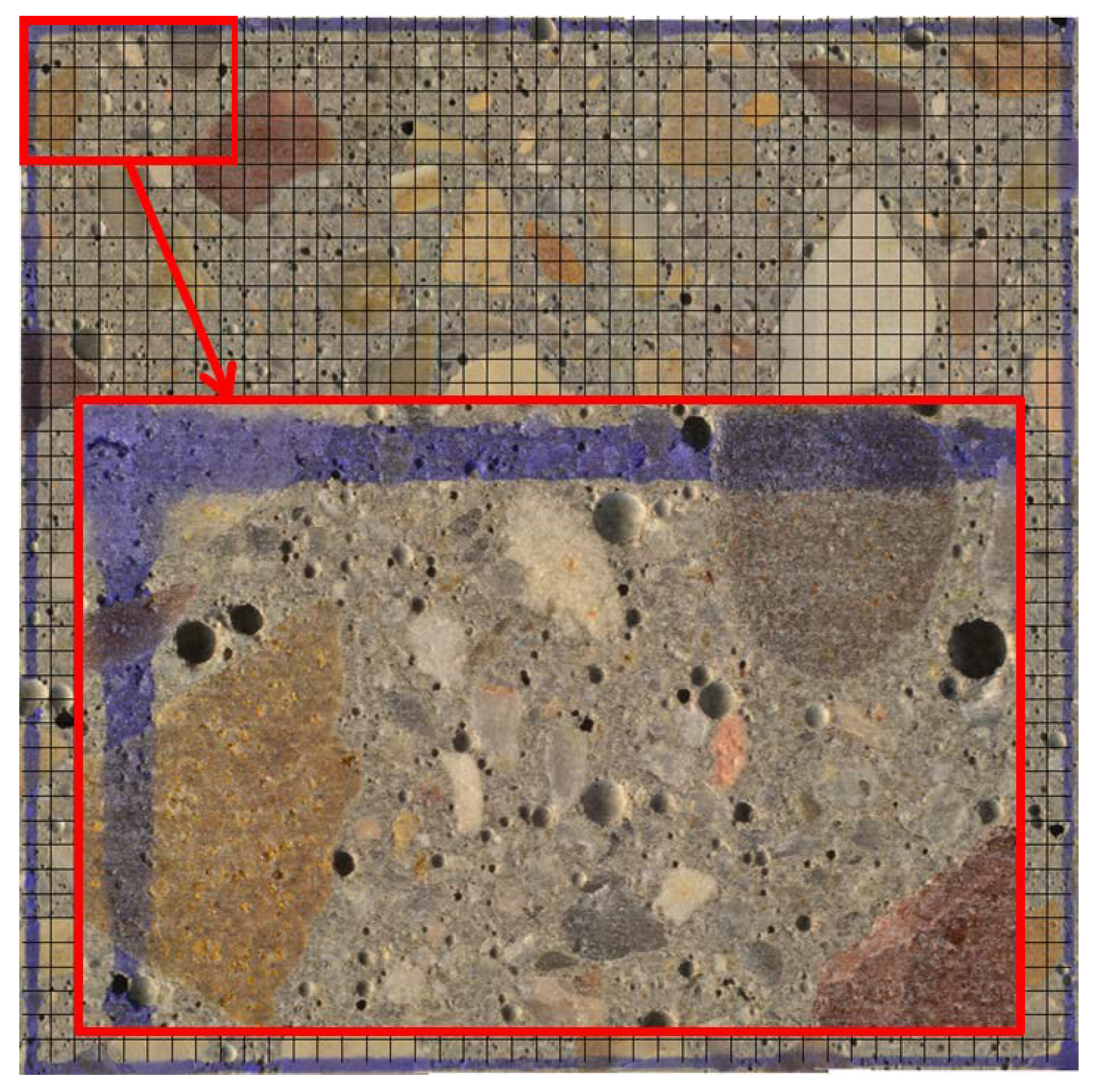
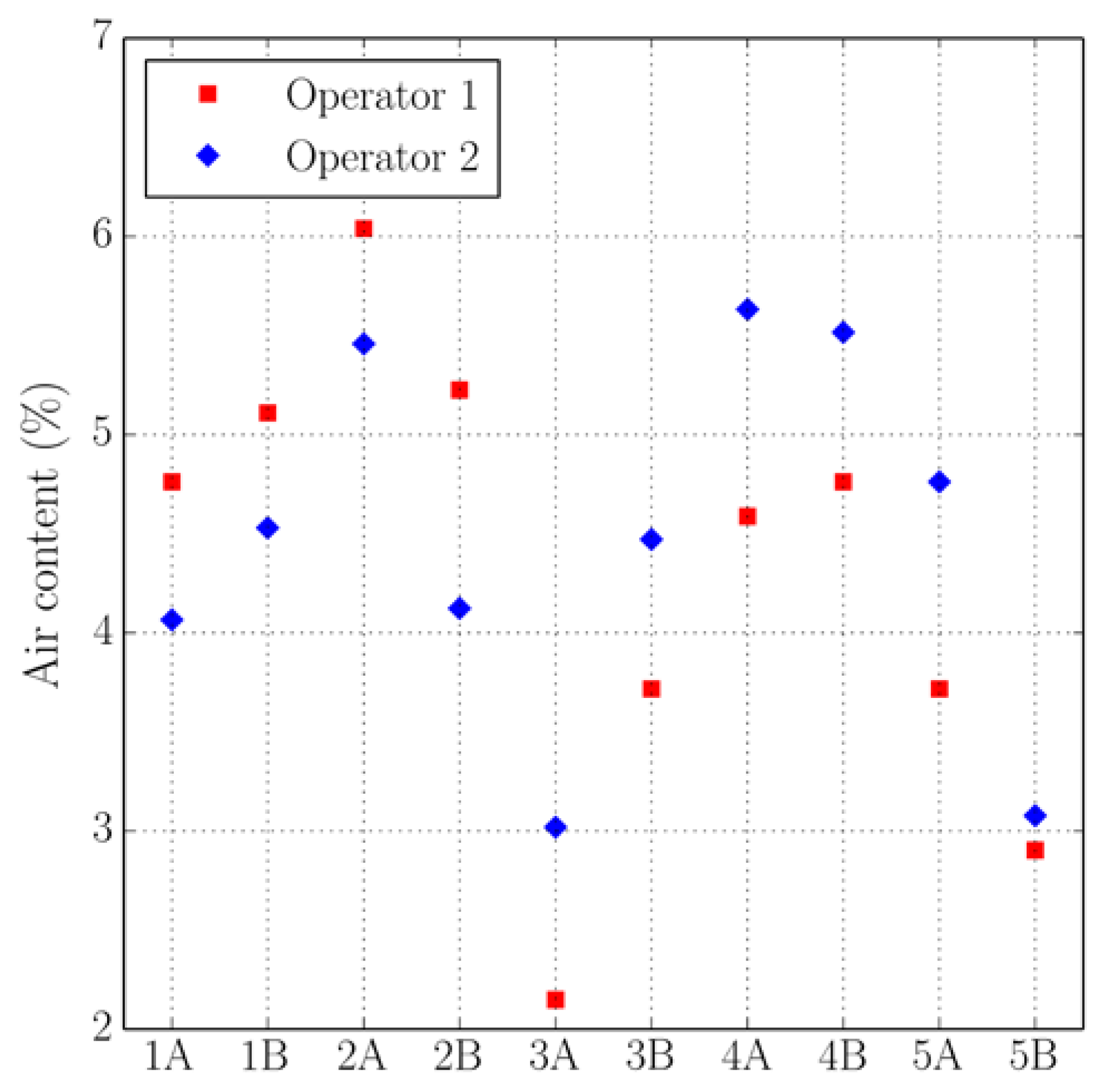

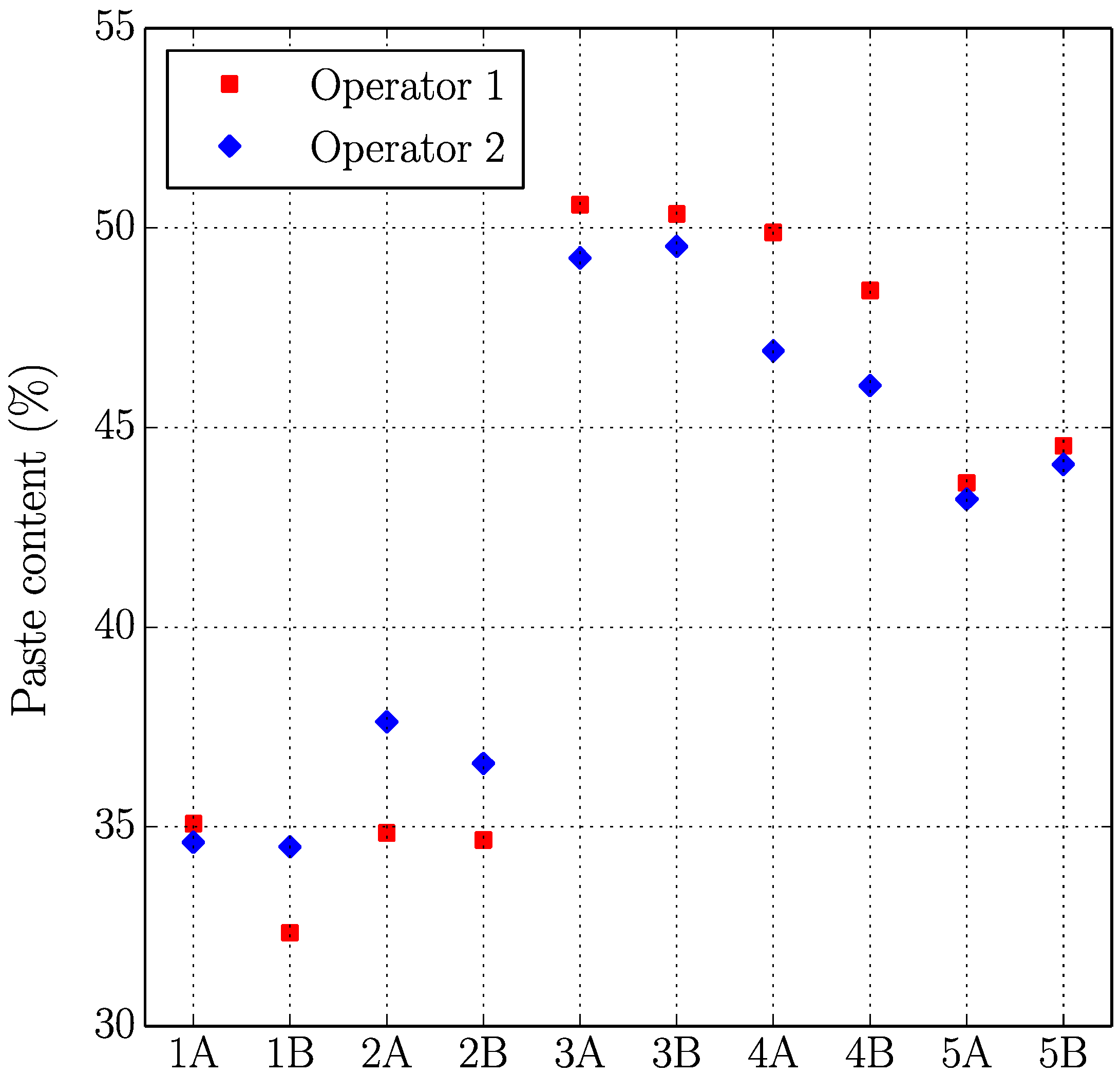
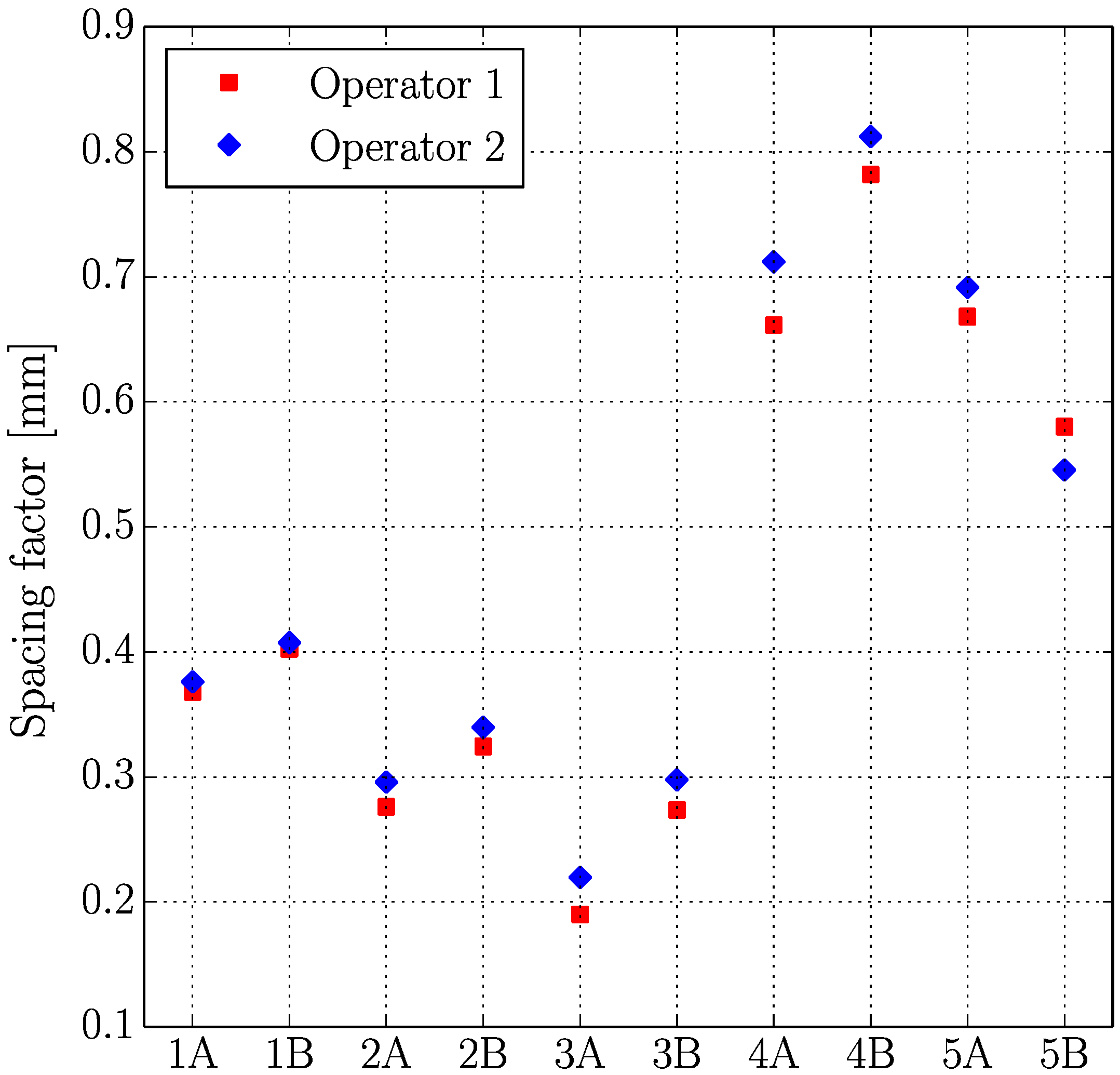
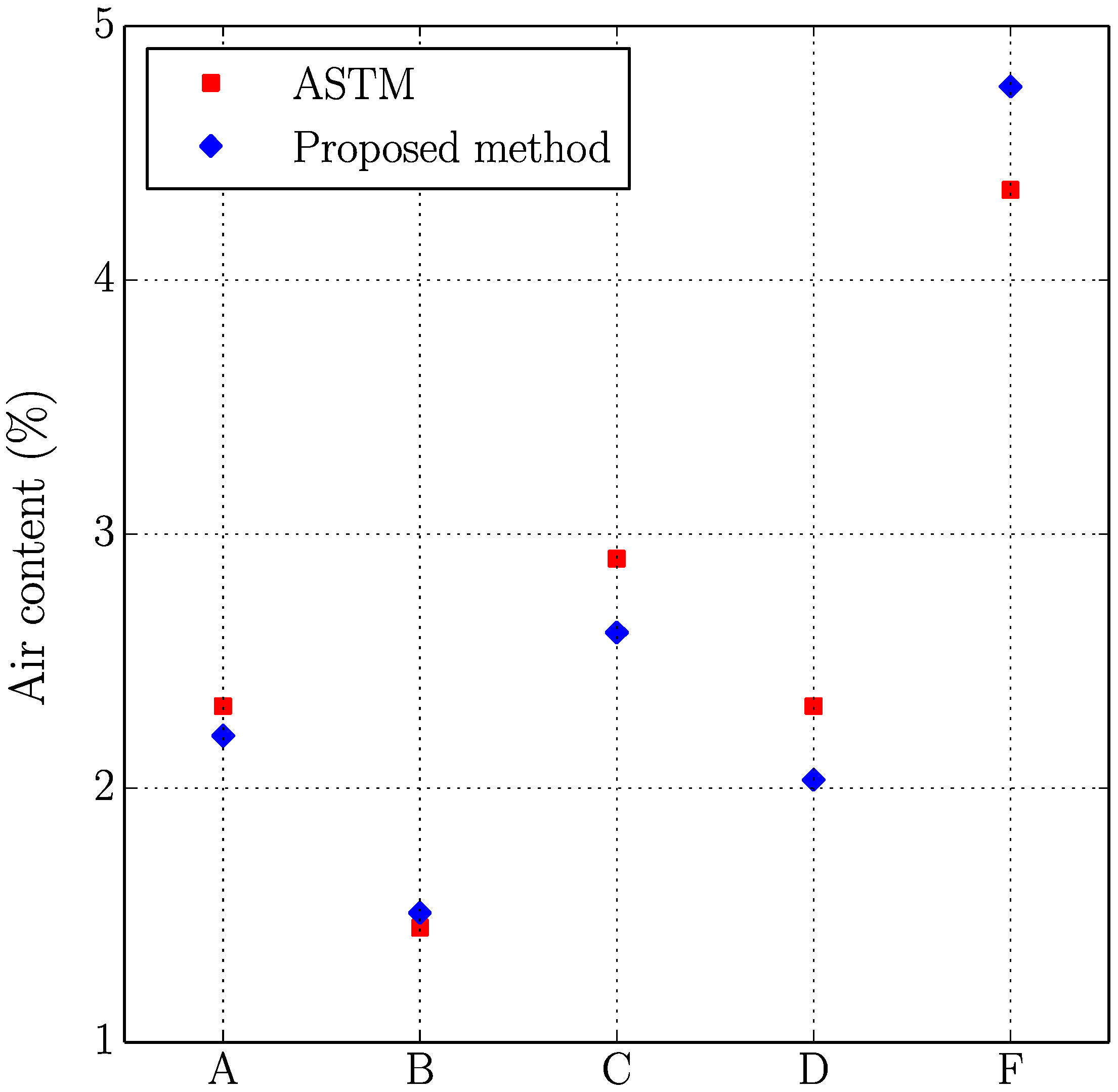
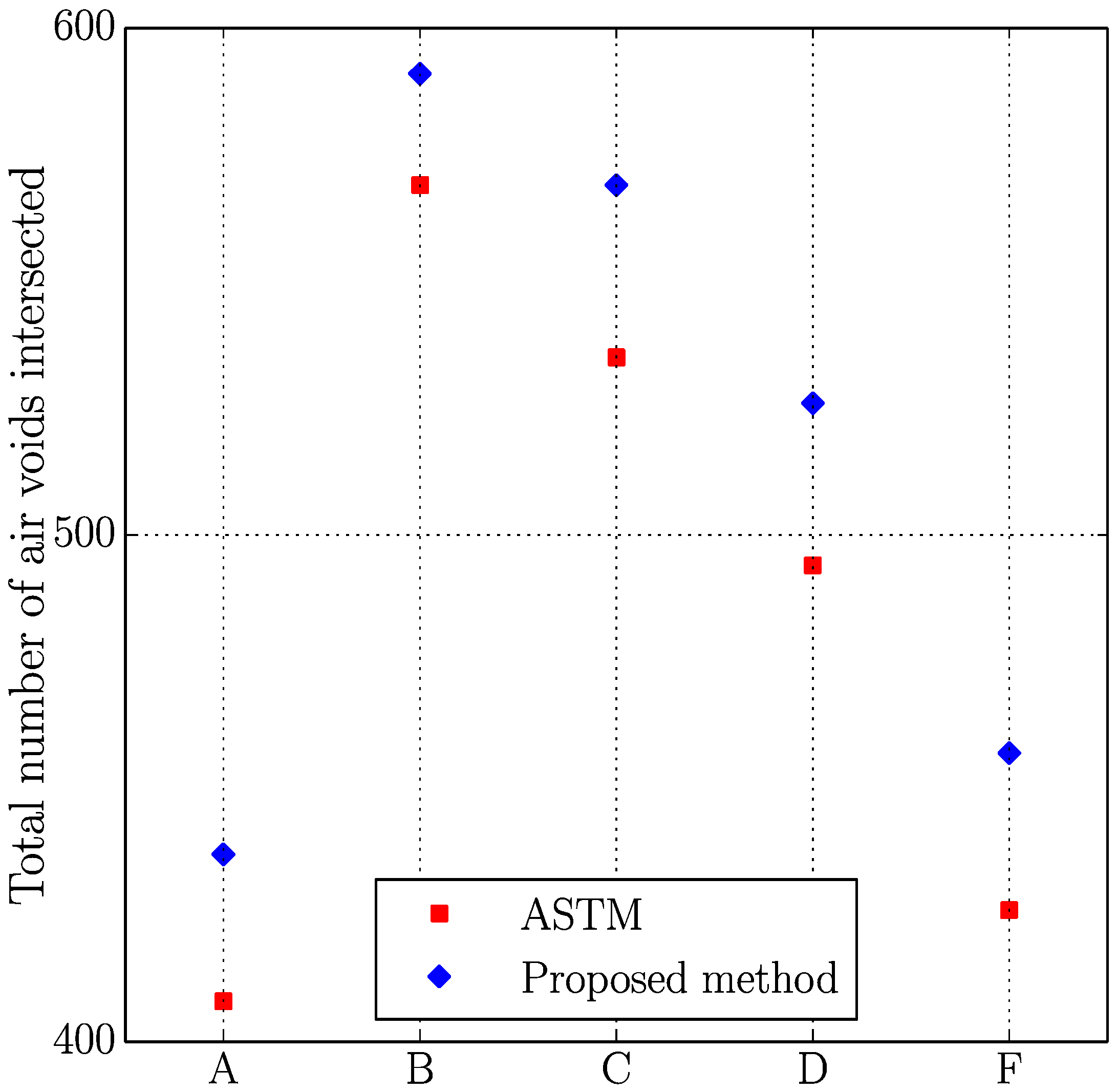
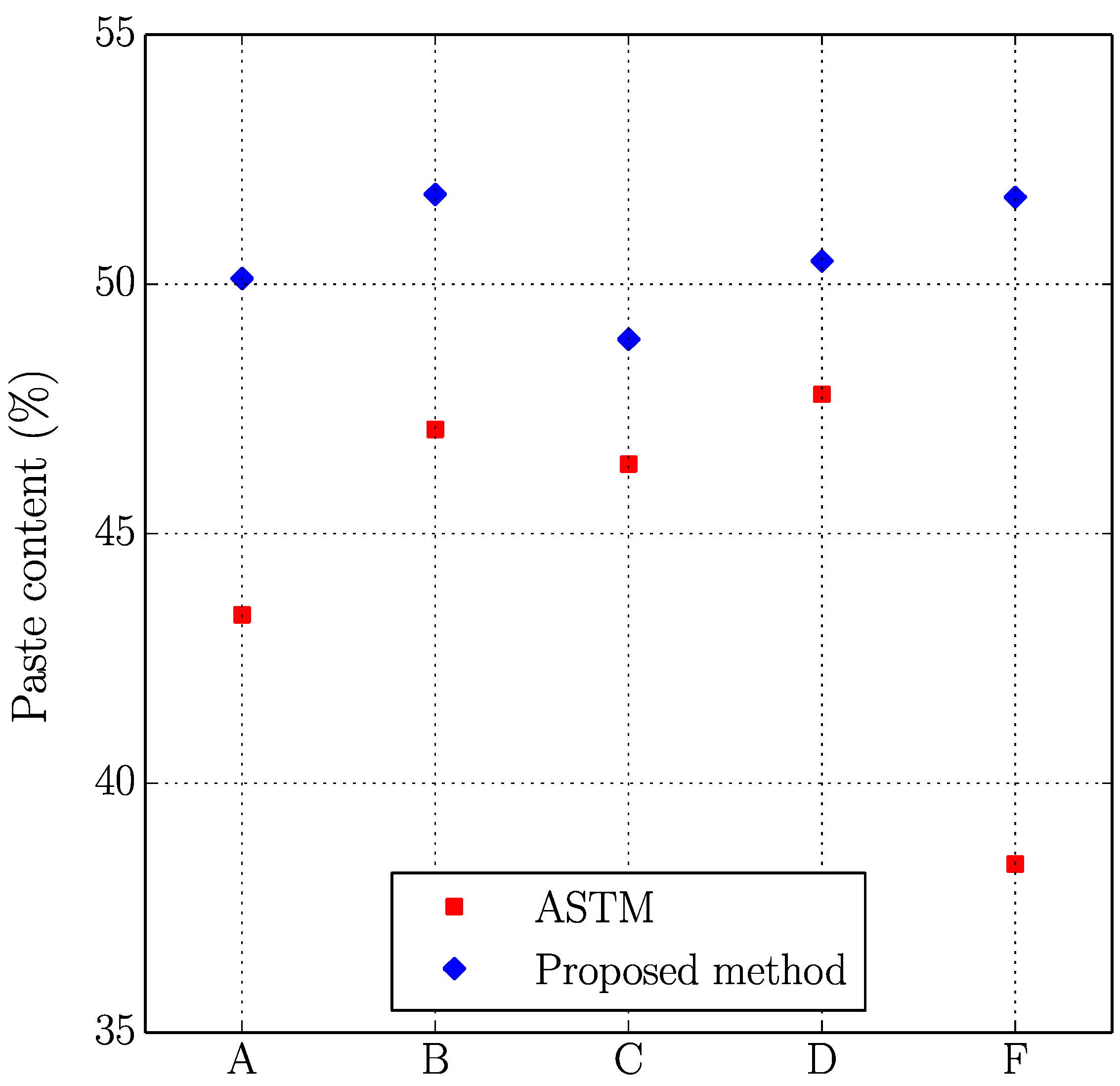
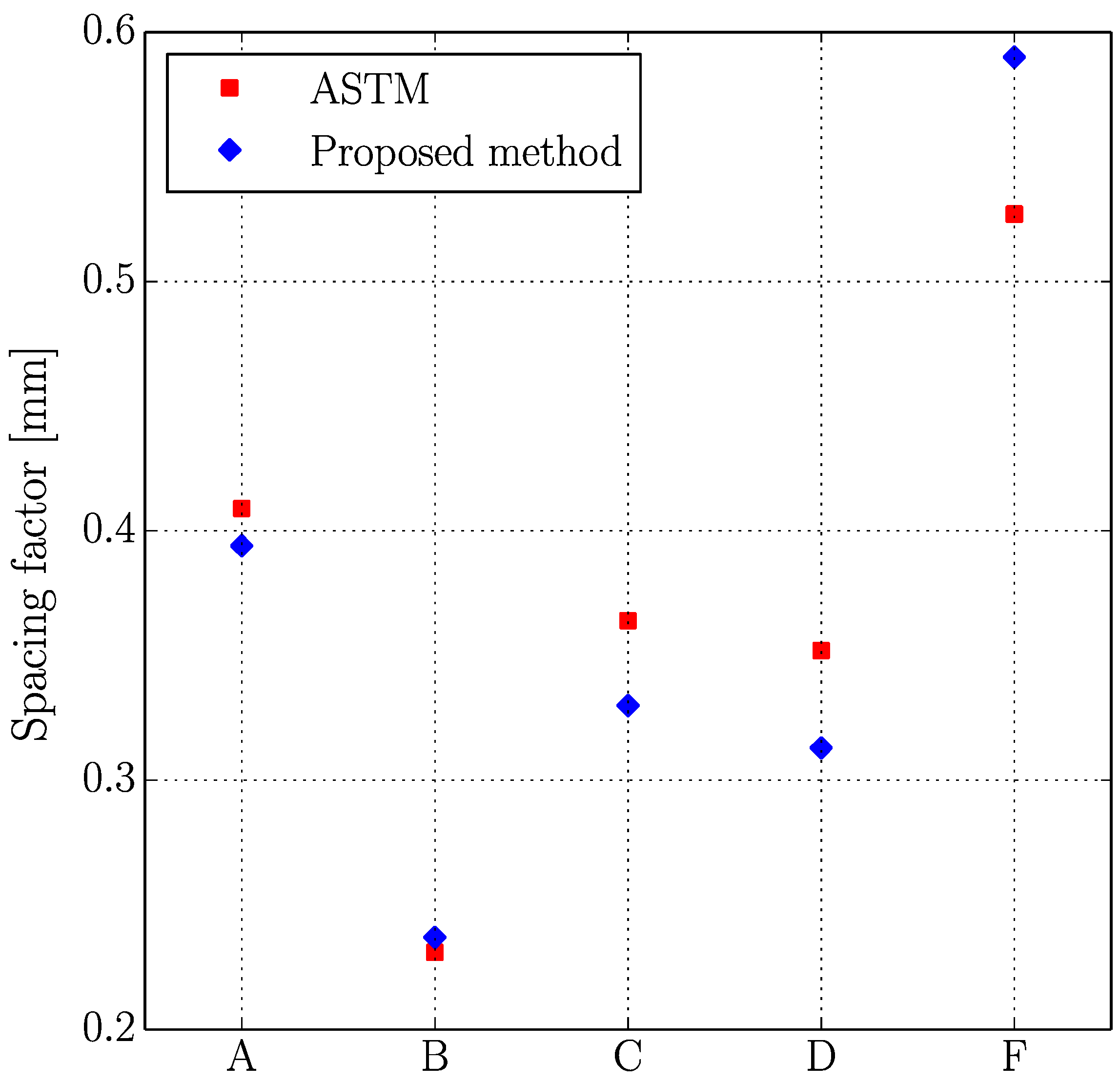
| Item | Standard Deviation (1s) | Range of Two Test Results (d2s) | Percent of Average | |
|---|---|---|---|---|
| Coefficient of Variation (1s%) | Range of Two Test Results (d2s%) | |||
| Air content %: | 0.80 | 2.27 | 13.8 | 39.1 |
| Voids intersected/cm [in.]: | 0.16 | 0.46 | 6.6 | 18.5 |
| Paste content, % | 1.65 | 4.65 | 3.9 | 10.9 |
| Spacing factor | 0.02 | 0.07 | 7.5 | 21.2 |
| Item | Air Content (%) | Air Voids Intersected | Paste Content (%) | Spacing Factor | ||||
|---|---|---|---|---|---|---|---|---|
| Op. 1 | Op. 2 | Op. 1 | Op. 2 | Op. 1 | Op. 2 | Op. 1 | Op. 2 | |
| 1A | 4.762 | 4.065 | 616 | 549 | 35.075 | 34.611 | 0.368 | 0.376 |
| 1B | 5.110 | 4.530 | 564 | 537 | 32.346 | 34.495 | 0.402 | 0.407 |
| 2A | 6.039 | 5.459 | 931 | 852 | 34.843 | 37.631 | 0.276 | 0.296 |
| 2B | 5.226 | 4.123 | 731 | 628 | 34.669 | 36.585 | 0.324 | 0.340 |
| 3A | 2.149 | 3.020 | 896 | 931 | 50.581 | 49.245 | 0.190 | 0.220 |
| 3B | 3.717 | 4.472 | 848 | 858 | 50.348 | 49.535 | 0.274 | 0.298 |
| 4A | 4.588 | 5.633 | 393 | 398 | 49.884 | 46.922 | 0.662 | 0.712 |
| 4B | 4.762 | 5.517 | 335 | 342 | 48.432 | 46.051 | 0.782 | 0.812 |
| 5A | 3.717 | 4.762 | 326 | 360 | 43.612 | 43.206 | 0.668 | 0.691 |
| 5B | 2.904 | 3.078 | 340 | 361 | 44.541 | 44.077 | 0.580 | 0.546 |
| Item | Standard Deviation (1s) | Range of Two Test Results (d2s) | Percent of Average | |
|---|---|---|---|---|
| Coefficient of Variation (1s%) | Range of Two Test Results (d2s%) | |||
| Air content %: | 0.52 | 1.48 | 10.9 | 30.8 |
| Voids intersected/cm [in.]: | 0.14 | 0.40 | 7.1 | 20.2 |
| Paste content, % | 1.29 | 3.66 | 3.7 | 10.4 |
| Spacing factor | 0.01 | 0.02 | 2.6 | 7.5 |
| Research | Standard Deviation (1s) | Range of Two Test Results (d2s) |
|---|---|---|
| Results in this study | 0.54 | 1.48 |
| Results of the slabs prepared in originating lab and measured in originating lab submitted to ASTM C457 | 0.57 | 1.61 |
| Results of the slabs prepared in originating lab but measured in participating labs from the European study submitted to ASTM C457 | 0.71 | 2.01 |
| Research | Percent of Average | |
|---|---|---|
| Coefficient of Variation (1s%) | Range of Two Test Results (d2s%) | |
| Results in this study | 7.5 | 21.2 |
| Results of the slabs prepared in originating lab and measured inoriginating lab submitted to ASTM C457 | 8.0 | 22.6 |
| Results of the slabs prepared in originating lab but measured inparticipating labs from the European study submitted to ASTM C457 | 20.1 | 56.9 |
| Results of the slabs lapped and measured in participating labsfrom the European study submitted to ASTM C457 | 17.5 | 49.5 |
| Specimen | Air Content (%) | Air Voids Intersected | Paste Content (%) | Spacing Factor | ||||
|---|---|---|---|---|---|---|---|---|
| ASTM C457 | Proposed Method | ASTM C457 | Proposed Method | ASTM C457 | Proposed Method | ASTM C457 | Proposed Method | |
| A | 2.323 | 2.207 | 408 | 437 | 43.380 | 50.116 | 0.409 | 0.394 |
| B | 1.452 | 1.510 | 569 | 591 | 47.096 | 51.800 | 0.231 | 0.237 |
| C | 2.904 | 2.613 | 535 | 569 | 46.400 | 48.897 | 0.364 | 0.330 |
| D | 2.323 | 2.033 | 494 | 526 | 47.793 | 50.465 | 0.352 | 0.313 |
| E | 4.355 | 4.762 | 426 | 457 | 38.386 | 51.742 | 0.527 | 0.590 |
© 2018 by the authors. Licensee MDPI, Basel, Switzerland. This article is an open access article distributed under the terms and conditions of the Creative Commons Attribution (CC BY) license (http://creativecommons.org/licenses/by/4.0/).
Share and Cite
Suárez, F.; Conchillo, J.J.; Gálvez, J.C.; Casati, M.J. Macro Photography as an Alternative to the Stereoscopic Microscope in the Standard Test Method for Microscopical Characterisation of the Air-Void System in Hardened Concrete: Equipment and Methodology. Materials 2018, 11, 1515. https://doi.org/10.3390/ma11091515
Suárez F, Conchillo JJ, Gálvez JC, Casati MJ. Macro Photography as an Alternative to the Stereoscopic Microscope in the Standard Test Method for Microscopical Characterisation of the Air-Void System in Hardened Concrete: Equipment and Methodology. Materials. 2018; 11(9):1515. https://doi.org/10.3390/ma11091515
Chicago/Turabian StyleSuárez, Fernando, José J. Conchillo, Jaime C. Gálvez, and María J. Casati. 2018. "Macro Photography as an Alternative to the Stereoscopic Microscope in the Standard Test Method for Microscopical Characterisation of the Air-Void System in Hardened Concrete: Equipment and Methodology" Materials 11, no. 9: 1515. https://doi.org/10.3390/ma11091515





